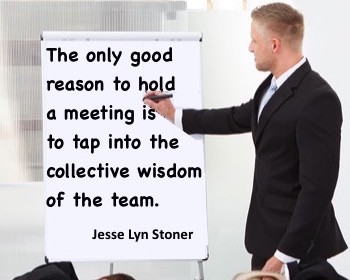 How many of your meetings begin with people opening their laptops, ostensibly to take notes and reference documents? Most of us know they are really answering email, conversing on social media and cruising the Internet because we’re doing it too.
How many of your meetings begin with people opening their laptops, ostensibly to take notes and reference documents? Most of us know they are really answering email, conversing on social media and cruising the Internet because we’re doing it too.
How effective are meetings where less than half the people are paying attention at any given moment? According to studies, managers spend about 35% to 50% of their time in meetings. And most of them report it is a waste of time.
Instead of blaming your team, take a look at why they aren’t interested. Holding a meeting to share information is not a good reason to meet. You can use easily use technology and project management tools for that. Why are you holding meetings?
The only good reason for a team to meet is to build and tap into collective wisdom.
Engaged Meetings Look Like This. Do Yours?
⇒ A common perspective and big picture view emerges where team members feel responsible for the success of the team, not just their individual area of responsibility.
⇒ Team members talk with each other, not just with the team leader, utilizing each other’s expertise.
⇒ The energy flows in all directions because their opinion affects the outcome. If everyone is looking at the team leader, the energy is flowing in the wrong direction.
⇒ The team makes joint decisions using everyone’s best thinking.
⇒ Team members work together on things that cannot be accomplished by working separately.
⇒ Relationships are strengthened and trust increases, which helps team members work together better outside of meetings as well.
7 Tips to Hold Engaging Meetings That Matter
1. Create a focused agenda, where the purpose of the meeting is clear and each item on the agenda supports the purpose. Ensure each item really needs to be included in the meeting and can’t just as easily be shared via email or technology.
2. For each agenda item, identify the conversation that needs to occur and what decisions need to be made.
3. As a team, identify and agree on clear norms around attention and participation. If an agreement is broken, address it, don’t ignore it.
4. Share leadership. Encourage team members to take responsibility for leading the conversation on agenda topics that are relevant to them.
5. Help team members develop effective communication skills, especially in listening for understanding and how to make a point without hogging the spotlight.
6. Document and review next steps. People are more invested when they know something is going to happen as a result of the meeting.
7. End on time! This might seem like a small thing, but it demonstrates that you value everyone’s time. And it forces you to stay focused and not waste time during the meeting.













Great tips! Glad you didn’t include the old standards like send the agenda ahead of time or create rules. Thanks for getting to the heart of the matter.
Indeed. Some of the standard meeting management practices are helpful, but many are control-oriented, and most do not address the underlying issue that the meeting itself is not worthwhile.
Many wonderful insights Jesse! Thanks for sharing them and for reminding leaders that introspection and self-awareness are important building blocks of leadership success.
Truth. One of the most important questions leaders can ask is “why?” and especially of themselves.
If only people followed these clear simple guidelines! 😊
It is simple. There’s a wonderful opportunity when you bring people together and it’s a shame to waste it.
Great post and valuable suggestions. This says it all: “The only good reason for a team to meet is to build and tap into collective wisdom.”
… and if that isn’t happening, don’t waste everyone’s time with a meeting. So glad you found it helpful John.
I once wrote a paper about MINM– Meetings I never miss. The crux was exactly the points you made. Everyone was engaged, it was meaningful, and we walked away with our clipboards ready to go!
One other point: make sure the right people are in the meetings.Have a general meeting with everyone can also be a time waster. Whose contributions do you REALLY need?
Great point about making sure the right people are at the meeting. The purpose of the meeting dictates everything, including attendance. Thanks for sharing your insights Eileen.
These tips are great! Meetings can be really boring, but as you’ve said, with the right actions, you’ll be able to keep your staff engaged a lot easier. Great post!
Thanks Sarah. So glad to hear you found this helpful. We’ve all been in way too many boring meetings!